The philosopher-architect Christopher Alexander devoted his entire life to the questions of “what creates more life?” and “what creates wholeness?” He considered this question across all categories: people, animals, ecosystems, landscapes, gardens, buildings, artifacts, art, and objects--- from the grandiose to the ordinary. His journey was both intellectual and empirical, philosophical and aesthetic, personal and universal. It led him to discard the many dualisms that plague us today --- subject/object; natural/man-made; wild/domestic; process/pattern. He intuited vast potential in the universe to create beauty and order, and remained persistent in his efforts to convince people that humans had this same capacity, if they were willing to look deeper into the “nature of order,” and “principles of wholeness.” His seminal work, a four-volume, 2000 page “essay on the art of building and the nature of the universe” is widely regarded as a singular achievement of the human mind and spirit. He inspired many architects, and his “pattern language” approach to design sparked a side industry of pattern languages across many disiciplines.
Alexander understood that the human subject was not separate from their environment, but somehow the interior forces and the exterior forces flowed together as a whole. The key to creating move aliveness was to enable all the forces to work together in a generative way. When all the forces are coherent, a new quality emerges, a “quality without a name,” something both ordinary and sacred. Speaking of his vision of a living world, he wrote, “the core of the matter lies in the way that centers are being formed.”
For Alexander, living centers are not built from parts, but from flows of unfolding forces. He proposed that
all living processes “are composed of millionfold repeated applications and combinations of a single type of unfolding process, governed by certain transformations which make each center help the larger centers and thus keep creating living wholes.
I believe all living processes are sequences, or combinations, or combinations of combinations, of this kind of unfolding process.
Centers involve flows of animals, plants, elements, the earth’s hydrological, meteological, astrological cycles, people’s work, play, leisure--- street corners, gardens, an old tree stump, a hearth, a horse cart --- are all in some sense both living centers as well as centers of life, receiving and generating flows.
Alexander describes the places that most exemplify this living quality. They are not slick, pristine, well-groomed modern places. They are places where we feel we belong, just like we feel a belongingness in nature. They have a “rubbed-in, used, quality.” They are living processes because they have been lived by people and people have lived through them. The quality, just like life itself, is “rough and ready,” while also evoking pleasure, ease and familiarity. No design, created purely out of context, has this quality initially. It must be worn into the place by the living flows of people, animals, plants, and other creatures passing through. Objects find their way there, to occupy their places too, contributing to this quality. Alexander recognizes the quality as the Japanese term “wabi-to-sabi” or “rusty beauty.” In our fast paced world, we do not have the luxury of building through timeless living process, where the building up and wearing in of the place happens continuously. “But,” Alexander writes, “some buildings, some landscape --- invite it, encourage it, foster it.”
The key point here is that wear itself is a design principle.
Side bar
Wabi-Sabi Zen is the place where objects tell their stories. Wabi refers to the inner life, a spiritual path or narrative, in other words, *the story. Sabi *refers to material things, the objects. Zen refers to the practice of attention --- to the mind that notices.
Wabi-Sabi Zen refers to storied objects and the mind that notices.
Wabi-sabi is a Japanese aesthetics that is associated with the earthen & elemental materials, whose form has grown organically, and whose shape, textures, shades and hues are a result of being weathered by natural processes over time. Wabi-sabi explores impermanence, the ability to cherish an object in its passage through time. In this sense, wabi-sabi is not separable from its story and its environs.
What to Notice
a fragile ‘thou”, a hungry tiger, a steamed pod on my plate, the color of orchard grass, the scent of abandoned bluebooks, a thirsty cow, an angry boss, the smiling farmer all coated with husk … the sweet lustre of one of your girls, the word someone tosses about like a head, tumbled with dreads… the way someone cries when they’re lonely, and laughs when they are simply alone — although I did not hear them then, I only hear them now
Ontological design depends on our capacity to sense the flows of wholeness and the living centers they can generate. The very first step is to understand our own selves as centers of generative potential. How we understand ourselves has enormous impact on what is possible for us to achieve. It is possible for us to create a beautiful world, places that thrive and in turn help us flourish.
In 1996 Christopher Alexander, the philosopher-architect was invited to be the keynote speaker at the OOPSLA conference. This may seem odd since OOPSLA stands for “Object Oriented Programming Languages and Applications.” At the dawn of the digital age, young people had found in Alexander’s pattern language approach, a powerful new way to build software. Code reimagined as place-making. Software reimagined as *objects that grow. *These were beautiful, powerful ideas that revolutionized our world. Yet, Alexander, always the formidable observer of *all the forces flowing through the system, *knew that something was amiss. The revolution was lacking the exactness it needed to make the vision of a more beautiful world unfold from the digital revolution. The man who had written 20 years before the conference of the “exactness” that was required to produce a certain living quality (“the quality without a name”) understood that it was somehow lacking in this generation of innovators. Alexander captured this notion in a passage about building a table for the blackbirds
Suppose that I am trying to make a table for the blackbirds in my garden. In winter, when the snow is on the ground, and the blackbirds are short of food, I will put food out for them on the table. So I build the table; and dream about the clusters of blackbirds which will come flocking to the table in the snow. But it is not so easy to build a table that will really work. The birds follow their own laws; and if I don’t understand them, they just won’t come. If I put the table too low, the birds won’t fly down to it. If it is too high in the air, or too exposed, the wind won’t let them settle on it. If it is near a laundry line, blowing in the wind, they will be frightened by the moving line. Most of the places where I put the table actually don’t work. I slowly learn that blackbirds have a million subtle forces guiding the in their behavior. If I don’t understand these forces, there is simply nothing I can do to make the table come to life. So long as the placing of the table is inexact, my image of the blackbirds flocked around the table eating is just wishful thinking. To make the table live, I must take these forces seriously, and place the table in a position which is perfectly exact.
Lacking “exactness”, the promise of the digital revolution was just wishful thinking--- something most of us realize today. Back then, it would have come as a surprise even to those who were devoted to the vision, those who arrived at the future before the rest of us. Therefore, after a careful speech about beauty and wholeness, Alexander concluded with a dire warning:
I heard a rumor at breakfast that some of the people in this room have begun to worry about their jobs. I have no idea if that is true. But I was told there is an undercurrent of unease as to where all this---software design---is going. There is a huge expanding phenomenon of programming as an art, and yet an uneasiness about where it is all headed? What is it going to do?
My comment on this? Please forgive me, I’m going to be very direct and blunt for a horrible second. It could be thought that the technical way in which you currently look at programming is almost as if you were willing to be “guns for hire.” In other words, you are the technicians. You know how to make the programs work. “Tell us what to do daddy, and we’ll do it.” That is the worm in the apple.
What I am proposing here is something a little bit different from that. It is a view of programming as the natural genetic infrastructure of a living world which you/we are capable of creating, managing, making available, and which could then have the result that a living structure in our towns, houses, work places, cities, becomes an attainable thing. That would be remarkable. It would turn the world around, and make living structure the norm once again, throughout society, and make the world worth living in again.
This is an extraordinary vision of the future, in which computers play a fundamental role in making the world---and above all the built structure of the world---alive, humane, ecologically profound, and with a deep living structure. I realize that you may be surprised by my conclusion. This is not what I am, technically, supposed to have been talking about to you. Or you may say, Well, great idea, but we’re not interested. I hope that is not your reaction. I hope that all of you, as members of a great profession of the future, will decide to help me, and to help yourselves, by taking part in this enormous world-wide effort. I do think you are capable of it. And I do not think any other professional body has quite the ability, or the natural opportunity for influence, to do this job as it must be done.
Who, if anyone there, remembers that significant warning? It seems to me that it was the most important part of the occasion. It was both a golden moment and a missed opportunity for designing new ontologies for back loop realities. In 2009, following the OOPSLA event, in anticipation of the influence that Alexander’s The Nature of Origin might have on the agile community in specific and the programming community in general, a trio of young people1 wrote an article titled Agile, Anthropology, and Alexander’s Architecture: An Essay in Three Voices stating:
During its formative decades the software community looked twice to the Theories of Christopher Alexander for inspiration, both time failing to completely master the architect’s most useful insights. Now a third opportunity presents itself with Alexander’s recent publication, The Nature of Order. Serious apprenticeship, however, imposes a prerequisite of sober self-reflection and evaluation. What, really, is the nature of the developer’s tasks? Under what philosophical umbrella has the software community matured until now?
Part of the blame was placed on the community itself. Dave West argues that, despite Alexander’s influence to support design patterns --- first in the late 60’s and again in the late eighties--- “neither time has been for the better and that it’s our own damn fault.
Even if our profession was young and still seeking an understanding of itself and its task, in both cases we eschewed the tougher, more significant, teachings in favor of the more familiar but lesser ones. … We’ve hit a dead end with our overly rationalist ‘engineering’ mind set.
Part of the problem, however, lay in the language of patterns themselves. Patterns were taken up as rules to govern design, or instructions to be implemented, rather than as a compendium of examples derived from Alexander’s deeper insight into The Timeless Way of Building. This problem stalked the pattern language approach in almost all disciplines, eventually turning the promising efforts pattern-languaging communities into interesting exercises in pattern-matching abstractions. 2 The patterns themselves unfolded from Alexander’s deep insight into wholeness and sensitivities toward QWAN (the quality without a name), and without having them first, people --- programmers and builders alike--- could not piece them together to create beauty. Christopher Alexander himself recognized this shortcoming, which he curiously pre-warned us about in the beginning sections of *The Timeless Way of Building. *First, on the dedication page he wrote
To you, mind of no mind, in whom the timeless way was born.
Secondly, he wrote:
It is a process which brings order out of nothing but ourselves.
Thirdly, he emphasized
To seek the timeless way we must first know the quality without a name.
And the final installment of the introduction section, he wrote
Indeed this ageless character has nothing, in the end, to do with languages.
This recognition, led Alexander to a decades-long pursuit to understand unfolding wholeness. This pursuit led Alexander to a spiritual place, to a kind of religious conversion. As Jenny Quillien relates:
In Nature of Order the entire focus shifts … to wholeness. Holiness, if you will. Building for Alexander is a spiritual endeavor; the search for Go is low-key in the early books but comes out loud and clear in *NO. *(W)holiness of increased life in the built environment is his goal; unfolding is the methodology.
I few weeks ago I was at the house of friends of mine (and POP-UP School people to boot!) and saw a large container with beguiling ceramic beads in it. I picked out one of the nicest pieces, which was multicolored and jewel-like, and my friend said --- take it. Although we both knew it was the nicest piece, when she said “take it” I instantly knew it wasn’t “mine.” There was a more sober, earthier piece further down the pile. That’s the one I want to take back with me. My friend gave me an immediate smile of recognition.
In the article, Jenny reminds us that Alexander was experimenting with the different ways people responded to objects when instead of asking “which one do you prefer?” --- they were asked “which one is more like your ‘self’? People were surprised how much their perspective shifted between the two. Something different was being used to evaluate. In the first case that something was like an objective measure, something perhaps more generalized and socially conventional. In the latter case--- the “self” was evaluating the objects. Jenny reflects: “Alexander is counting on our ability as ‘living structures’ ourselves to discern between degrees of life in the objects around us and, with practice, to improve on that ability, making increasingly fine discernments.” To which Pam Rostal responds:
This reminds me of how C. S. Lewis described ‘joy’ as the feeling we get of being home in a place we’ve never been before. Somehow, the Absolute in such a place resonates with the Absolute within us.
The Nature of Order
The Nature of Order is itself a beautiful example of unfolding process. Christopher Alexander called it “an essay” 3 but it is not your everyday ordinary essay, since it runs over 2000 pages in total. To essay, also means to strive; and I think this is the sense he means --- he is essaying his way through the nature of order. The four volumes unfold as follows:
Book One: The Phenomenon of Life
Book Two: The Process of Creating Life
Book Three: A Vision of a Living World
Book Four: The Luminous Ground 4
Book One: The Phenomenon of Life
Book One begins with a prologue to the entire series. Here Alexander shares his difficulties in accepting the implications of his own journey--- spiritual and religious implications that his formal training, as a mathematician and empiricist would find ridiculous. “Even now, on some days,” he reflects,
I look at the theory I have formulated in these four books and can hardly believe that it is true. It provides a view of the universe which is so surprising, and so much at odds with the normal common-sense ways of thinking about physical reality we have currently, that it seems almost like a fantasy, like some kind of science fiction.
He was fueled by his commitment to understanding beauty and learning how people could reclaim the ability to build beautiful buildings and landscapes. He credits his success with basing everything on the real nature of human feeling --- that he has tried to honor and respect the capacity for people to feel what is beautiful, to feel what is more alive. Alexander quickly realized that our ability to create beauty is tied up with our conception of the nature of order. Being confused by the nature of order is the root of the problem of architecture. But no formal conception of the nature of order could correct this confusion. The solutions were to be found elsewhere---through processes where beauty and aliveness, and wholeness are disclosed--- in human feeling and open heartedness.
Alexander goes on to describe and illustrate how objects and scenes have different degrees of life. More degrees of life is related to a sense of wholeness, of connection and relationship, of the vitality of youth and also the sense of having accumulated experience. A slumhouse can have more life than a postmodern construction. His states his fundamental hypothesis as:
What we call “life” is a general condition which exists to some degree of other, in every part of space: brick, stone, grass, river, painting, building, daffodil, human being, forest, city. And further: The key to this idea is that every part of space--- every connected region of space, small or large--- has some degree of life, and that this degree of life is well defined, objectively existing and measurable.
But what is doing the measuring?
Alexander identifies what he calls “wholeness and the theory of centers” as the essential qualities in what has more life. A center does not have to be “in the center” of something. A center is a point of relation, a grounding point from which life can propagate. Take a blank sheet of paper. Mark it with a dot anywhere on the paper. The location of the dot determines what becomes possible --- the kinds of symmetries of asymmetries unfold from the chosen spot. A sheet of paper with a dot on it has a kind of wholeness that the paper does not. We might say the paper remains latent until the dot potentiates in it. The dot sits in a specific location, and implies what might unfold. There is a gradient array susbsisting in the possible relationships that the dot can unfold. The dot becomes a provocation. It already has meaning and generates meaning …

There is a felt sense of the latent potential of a greater wholeness and forces that make the situation come alive …
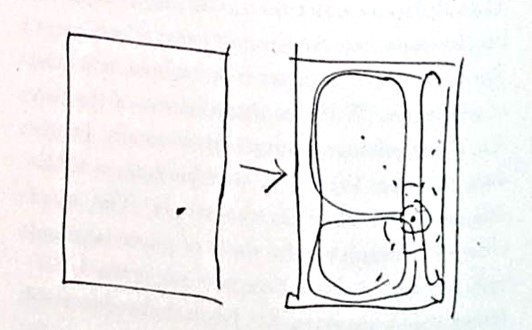
This simple exercise allows us to attend to the way that the body anticipates what comes next, where life is going --- perhaps the multiple directions that the forces are moving within. It is not a given. We get to amplify some of those forces and set aside others. 5
The word “center” and the term “wholeness” are very closely related. Something that is “whole” not only is composed of parts, wholes are composed of centers which ground, and free up the forces to generate wholeness. Look at the image of the tree below. Can you relieve yourself of seeing only whole-part relations and look more deeply to see the centers at all scales from which the wholeness grows …

In your minds eye, looking both from above or below, you might be seeing something like this
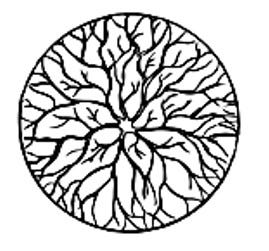
Look closer, look deeper, you would see incredibly rich complexity
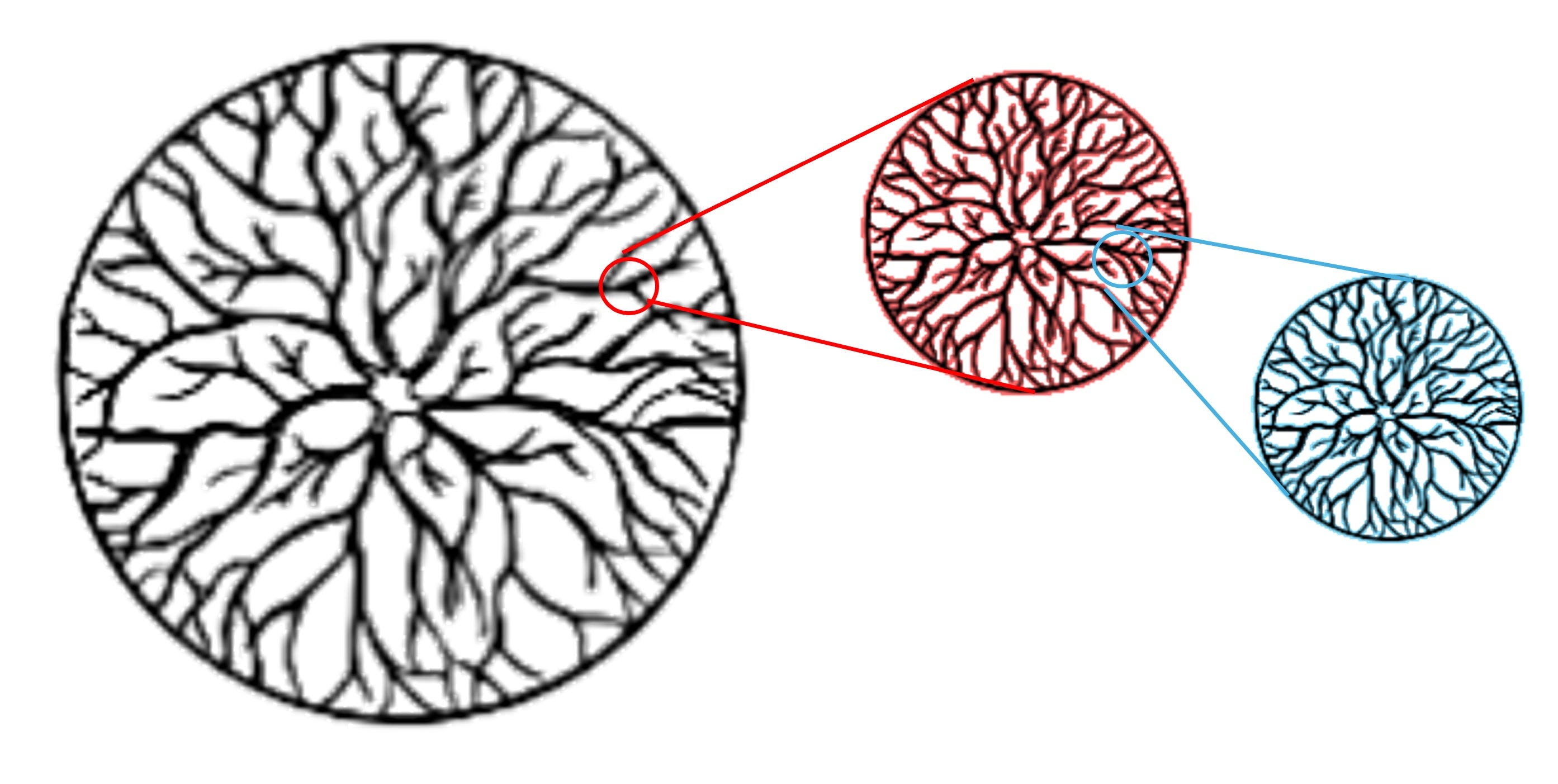
Now take a look at a forest of trees from above --- they produce more living centers, more dense patterns of wholeness …

Working with centers-unfolding-wholeness means capturing the essence of what creates these living patterns and employing that essence, that process of creating beauty, and generating more life.
Watch: Christopher Alexander's photos
Can you sense into the living centers of each photograph, notice what gives them life, what makes them wholes?
Life comes from wholeness and wholeness grows from living centers
Centers co-create themselves. This is not the same as a simple holarchy where there are lower parts and greater wholes. Wholeness can unfold from an original center, establishing other centers at both smaller and larger scales, and the original center may “disappear” and yet, still, somehow contribute to the wholeness and its ongoing unfoldment. For example, think of a tree that is a center in an opening of a forest. A strangler fig begins to grow around it and the tree eventually dies, leaving something like this:
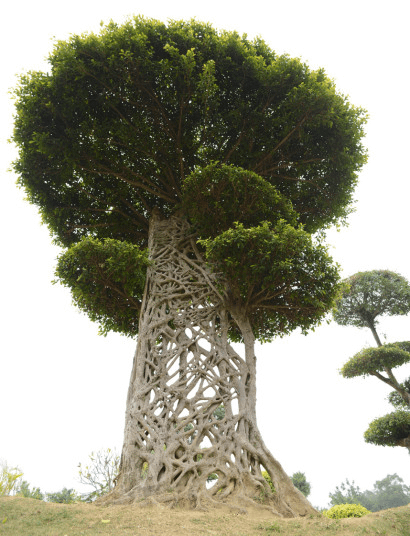
The original tree is somehow still the center of this wholeness, and yet it is no longer there. It is somehow there and not there at the same time. It is in a sense the center of the historical epoch of what today is the strangler fig landscape. The center is a seed or, as Carlos Casteneda would say, the assemblage point. It is an assemblage point in time, that is concretized as a living structure in space. Like the wind, which cannot be seen, only the effects of which can be perceived ---- the center is there and not there at the same time. It is pure temporicity.
Alexander also talks about centers as being composed of vector-like forces within a dynamic field. We intuitively perceive these forces and intuitively sense their center as the still point, the still point which is held by the balance of forces. The center is destroyed when the balance is distorted. Consider the following figure as an example of vector-flows or forces in a field:
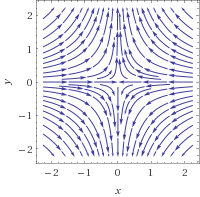
Consider also these images. Is there a still point or are there many still points that somehow compose a wholeness that has a center, although it is not the kind of center that you can point to--- it doesn’t exist in space, it is a reconciliation of forces in and across time.
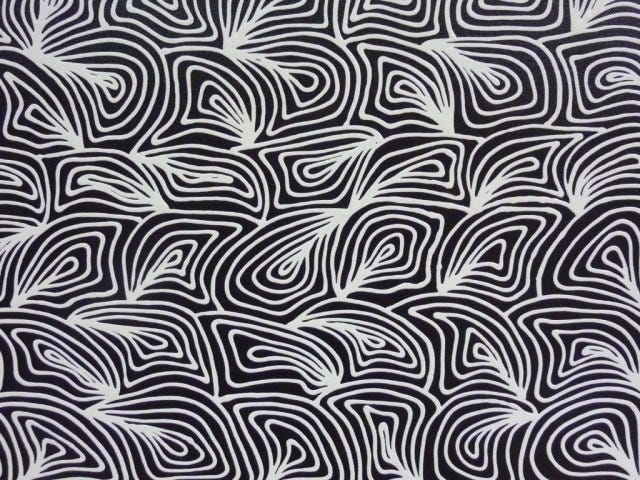
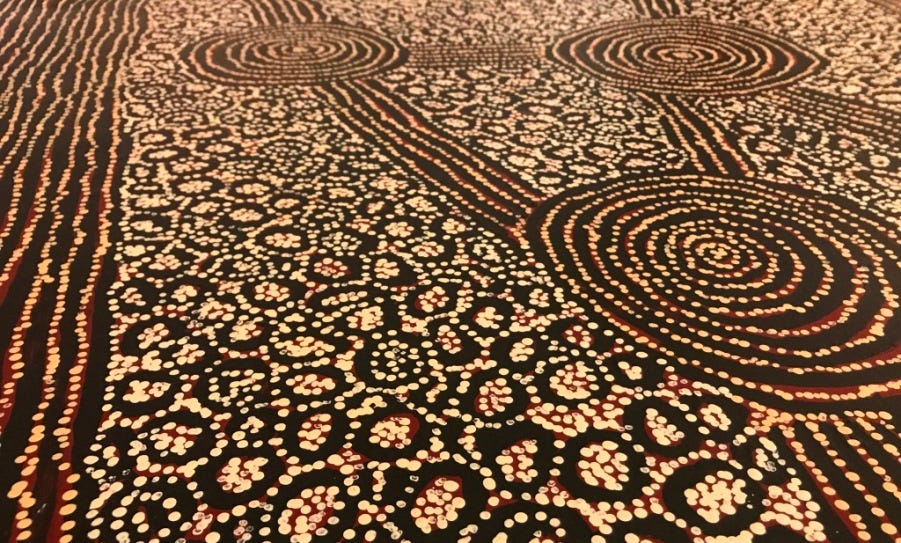

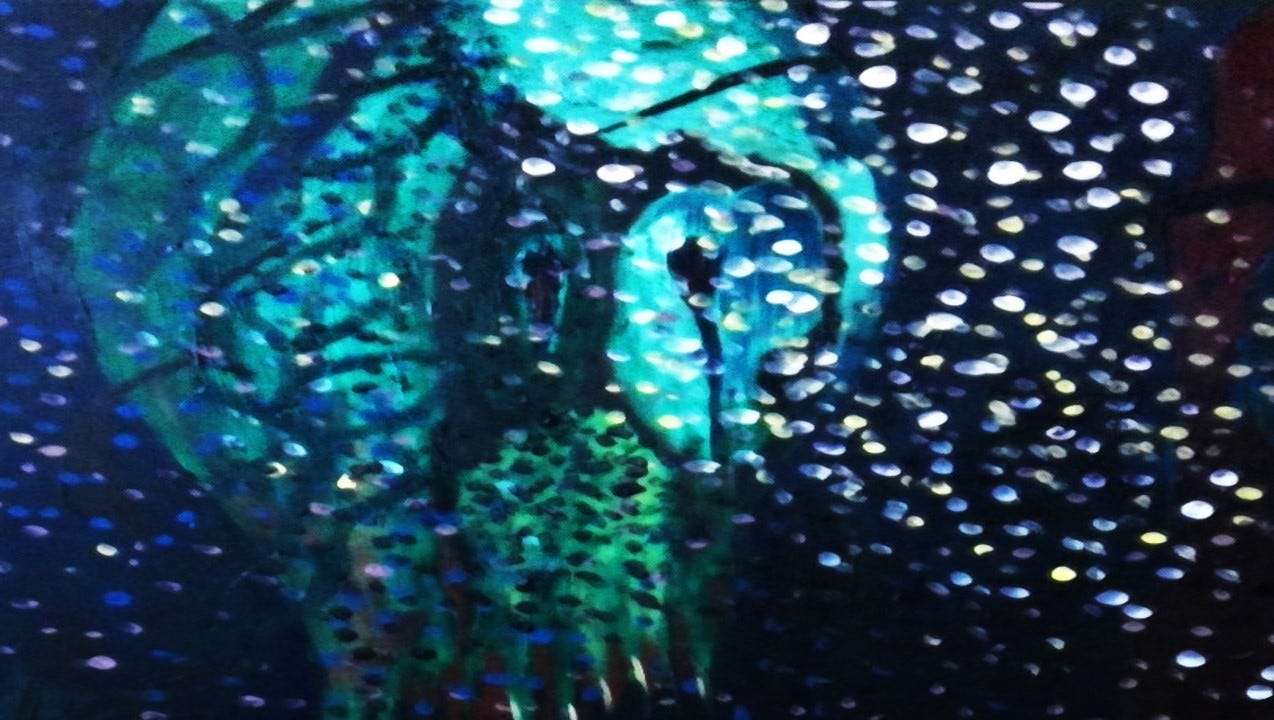
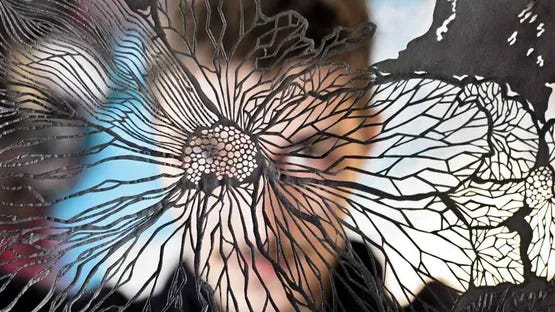
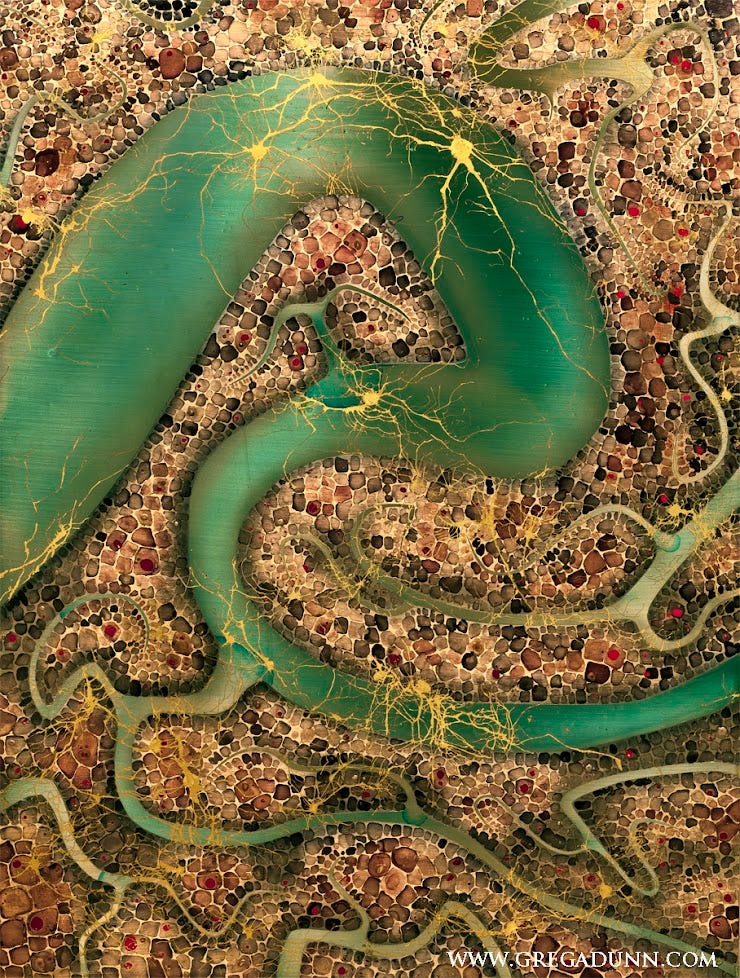
A structure, garden or landscape in which the forces are working against itself, has no center, and thus leans toward destroying itself. But what does “destroying itself” mean here? It means the tendency of the thing to seek life, to establish a living center around which the forces may become coherently whole. All “destructive tendencies” are actually this --- the force of life wanting to become whole.
In the midst of “destructive tendencies” Alexander calls for people to function as living centers, as seed-centers where life can spontaneously regenerate. What does this mean for we, the people gathered in between worlds, facing the earth’s 6th mass extinction?
In Part Two of Book One
Christopher Alexander introduces the surprising feature to his notion of living structure. He introduces this as follows: “[Living structure] cannot be fully understood if we regard them merely as something in Cartesian space, a mechanism separate from ourselves. Rather, it turns out that
[L]iving structure is both structural and personal …
it is both rooted in structure and rooted in feeling …
This attitude, this revelation, repairs the split between the objective and subjective aspects of experience, and
leads to a mental world where art, form, order and life unite our feeling with our objective sense of reality, in a synthesis which opens the door to a form of living in which we may be truly human.
It seemed to him to be an inflection point, a threshold moment at which the destructive forces of modernism may find their seed in the human, as the living center of a new, vital, vibrant, and thriving world.
What does it mean for something to be personal?
A thing is truly personal when it touches us in our humanity.
The trivialization of the word “personal” is part of our present popular culture, immersed in mechanistic cosmology. But from the point of view of the world-picture in this book, “personal” is a profound objective quality which inheres in something. It is not idiosyncratic but universal. It refers to something true and fundamental in a thing itself.
I believe all works which have a deep life and wholeness in them as “personal” in this sense. Indeed, this quality is an essential and necessary part of what I have identified as life in things. When we are dealing with realm of personal feeling in which feeling is a fact--- as much a fact as the radiation from the sun, or the swinging of a pendulum.
When the field of centers is authentic, it is always personal. If it appears to have the right structure but is not personal, it is empty structure, only masquerading as life--- and, in every case like this, it will turn out that we have misjudged it structurally. The existence of a personal feeling in a thing or system is not a subjective quality of limited validity, but an objective quality whose existence is as fundamental to any given situation as the more mechanical facts to which we are accustomed.
After introducing this notion of the personal, Alexander allows it to percolate in an invisible way through books 2 and 3, ultimately picking it back up and extending it to something even more surprising. His message --- that personal feeling, living centers, wholeness and the quality that makes things come alive --- are all somehow one integrated or equivalent notion. “Feeling and life” are somehow the same thing, he writes, and they are “integrated in each person’s heart,” erasing the structural duality of subjective/objective and in-here/out-there. This is architecture raised to the power of spirituality.
Alexander moves on to talk about the other side of the equation, in terms of the “mirror of the self.” If the object is experienced as feeling in the self, then the chiral twin of that is that the self is perceived in the object --- hence the object becomes the mirror of the self. The self, however, is mostly confused. It becomes distorted by living in ugly environments that are devoid of “self”, and we are misled by advertising and social opinions developed under the spell of materialism.
[Each] architect, each designer, is a little lost, mentally flailing around trying to do a good job without being sure what that means--- all because we have a foundation of quicksand for the judgments he/she/we are called upon to make every moment of the working day.
What is ecologically appropriate, what is socially and psychologically valuable, what is beautiful to the eye, what is comforting to the soul--- these are all wrapped up together in the global judgment of wholeness.
Toward the end of Book One, Alexander thought his experience of wholeness could be regarded as a rigorous scientific understanding of space. Returning to the exercise of a single dot on a blank sheet of paper, he writes: ”… the wholeness created by a single dot sitting on a sheet of paper consists of a series of convex segments of space.”
Alexander concludes Book One by reminding us that the built environment plays a significant role --- if not the most significant role --- in the possibility for humans to thrive. That life depends on life, has more to do than just with eating. Life needs to be surrounded by things that have life which are, by nature and design, expressions of wholeness.
By illustrating the existence of living structure, I have shown, I hope, that the phenomenon of life is something greater, more profound, and more general, than what we have come to this of, and accept, as biological life.
This is a new way of looking at architecture. The intellectual foundation of this vision is the idea that space itself, matter itself, has life in varying degrees. There is a convergence of function, geometry, and feeling in space; this space is conceived as a living fabric that--- through its structure--- encompasses these things. Space does not merely contain living structure. Space has life, to a greater or lesser degree. It is the space itself which resembles self, which functions, which works, which has living structure in it, and which has life.
The life which appears is an attribute of space itself.
Our job, as architects, builders, citizens, is to create this life in the air and stones and rooms and gardens--- to create life in the fabric of space itself. This is not merely a poetic way of talking. It is a new physical conception of how the world is made and how it must be understood.
In Book Two, The Process of Creating Life
Christopher Alexander, toward the end of the book, introduces the notion of Deep Feeling --- which is that which is attune to, evaluating what has more life. He describes this one insight as “the most important and profound aspect of living process,” “the most enlightening and appealing,” as wells as, intellectually, “the most controversial and the most difficult to accept.”
The illiterate of the future will be those who cannot feel.
– Bonnitta Roy
The difficulty today is that, as we move through devastated and ugly environments, we train ourselves not to feel --- since the feelings that these environments evoke are painful. We retreat into a dense core of numbness. Ontological design for a living world, therefore, begins with learning how to feel, and this in turn depends upon being able to access islands of sanctuary.
It is important to note that this is where many people get Alexander wrong. They think he is using the word “feeling” in a psychological way. But he is not. He is pointing to something that is subjective, but not psychological, but also objective--- something that is inherent in the object. He is pointing out a specific organ of perception that most modern people no longer use to evaluate beauty in terms of wholeness, aliveness, and what belongs with what, where and when. It is a term that gives us the capacity for ontological design.
Interactive
One way to get started with this new sense of “feel” is to work with color. Here are two interactives game that awakens the deep, embodied evaluative senses in you. Let us know in the comments what you think.
https://color.method.ac/
https://trycolors.com/games/guess-mix
The person who feels mostly in the psychological sense is vulnerable to all kinds of manipulation from propaganda, advertising, and social media. The limbic system is overwhelmed and operates at high tension on a continuous basis, drowning out the capacity to feel in the second sense of an evaluative, discerning, organ of perception. When you play the interactive game above, you might experience the two sense of “feeling” oscillating. You start working with the colors in an perceptual sense, but then you are getting frustrated that you are failing, and the psychological sense of feel starts to overwhelm your ability to attend to the game with the evaluative sense of feel. Oscillating back and forth between a feeling of attending and the psychological feelings, you can begin to discern the difference.
The feeling that is a perception participates in a feedback-loop with action in the world that satisfies the perceptual arousal. The feeling that is psychological never satisfies --- it merely dissipates. Wholeness, aliveness, and living centers are perceived through this feeling organ, especially as it participates in the world. This feeling organ may turn out to be, as Alexander suggested, “the greatest importance for the future of mankind.” And yet, “for us, in our era,” Alexander writes, “it is not so easy.”
The word “feeling” has been contaminated. It is confused with emotions--- with feelings (in the plural) such as wonder, sadness, anger---which confuse rather than help because they make us ask ourselves which kind of feeling should I follow?
The feeling I am talking about is unitary. It is feeling in the singular which comes from the whole. It arises in us, but it originates in the wholeness which is actually there. The process of respecting and extending and creating the whole, and the process of using feeling, are one and the same.
Real feeling, true feeling, is the experience of the whole.
As an example, Alexander compares art as expression of feelings with “feeling in the work of art.” In the first case which he says is “not very interesting” is when the artist puts their feelings into the work of art. In the second case, what he calls the essential case, the work itself, its unfolding process generates feeling in the artist, guiding the artist toward the wholeness that is there and not yet there. The wholeness that guides has the quality of latency, and the artist unfolds its potency. He writes
What matters is that the building--- the room, the canyon, the painting, the ornament, the garden--- as they are created, send profound feeling back towards us.
The feeling itself grows toward a greater wholeness, from anticipation and perhaps reticence towards resonance, confidence and recognition. The artist and the work compose one living center that grows. Each step guides us toward the next, “we can grasp the latent structure as an emotional substance, we may feel it as a vision--- a dimly held feeling which describes where we are going, but is not yet concrete … ”
And above all, it is a movement toward a structure which makes us feel our own existence more deeply.
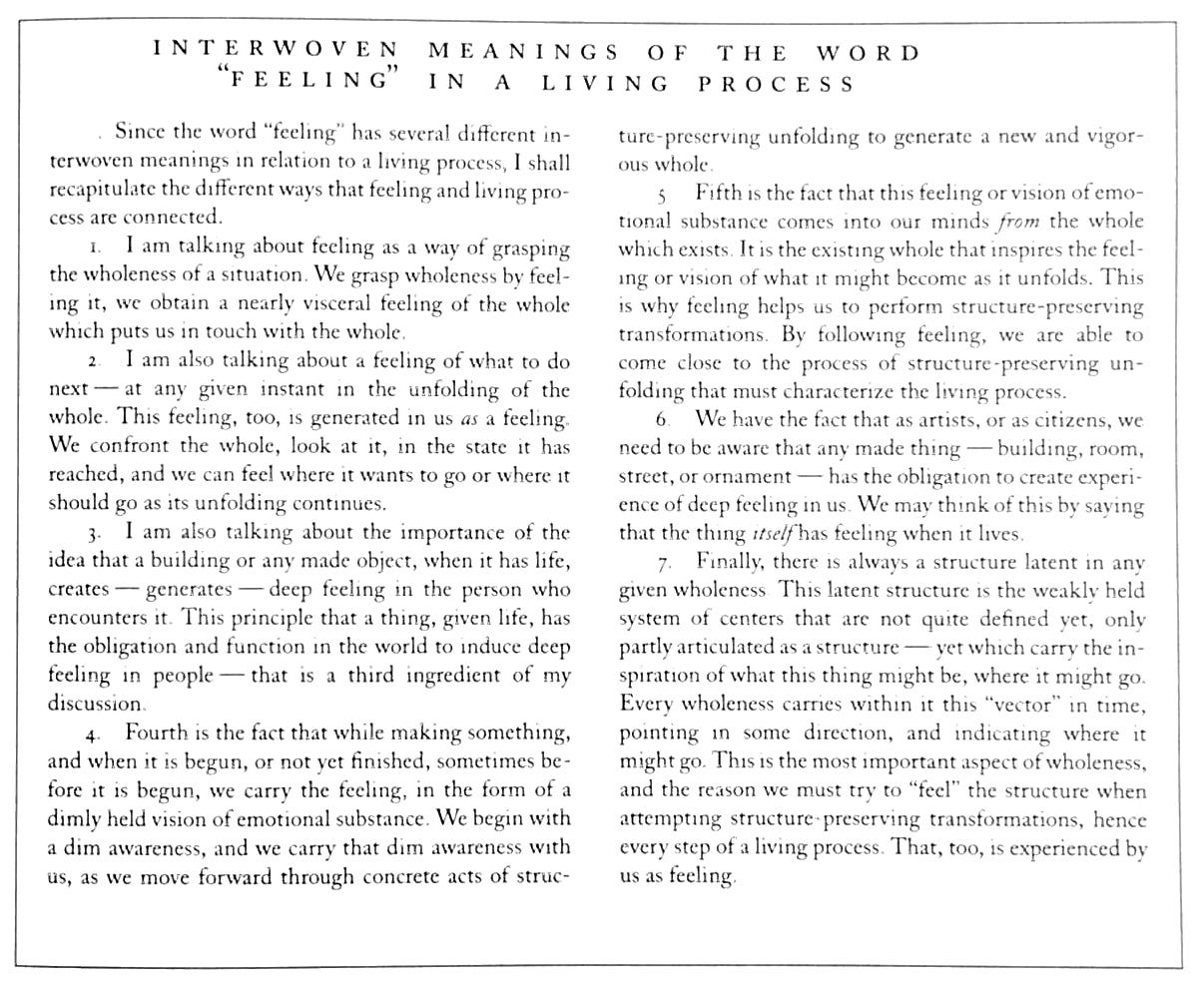
Book Three : A Vision of a Living World
In Book Three Christopher Alexander outlines the kind of process approach to world-building that would secure whole living structure. The idea is that when the builder becomes living process, then what they build unfolds from their center as living structure.
The result does not need to be governed by ideas or by conceptions of what might exist; indeed, conceptual ideas are often harmful. The whole is governed, at each stage, by what is.
The process itself fosters wholeness and life.
Living structure, he says, enables people to truly enjoy belonging to the earth. In terms of contemporary built-space, this is a transitive equation: we don’t feel like we belong to our public spaces, because our public spaces don’t belong to us--- they are faceless, nameless structures where neither the individual nor the multitudes of differences are reflected. This condition imposes a severe blight on human subjectivity. Up until the modern era, Alexander writes, in traditional society, the public spaces between buildings was like “the living room of society.”
Public land was the living room for society.
Where does Sakraji get the dignity and joy he has? He gets it because he belongs, wholly to his village, and it belongs to him. And how does he get this belonging? He gets it because he and his villagers control everything in their environment.
This is a matter of governance. “Design alone cannot accomplish this.” Alexander writes. “It needs a change in the way we make it possible for people to control the world around them.”
At the very end of Book Three, Alexander takes up the role of color. Color, when employed fully and in harmony, “produces inner light.” It is this idea that will become the central focus of the final book --- the self-luminosity of things that have life--- they become radiant. Radiance is the light that shines from the living centers. Here Alexander is getting close to the mystical aspects of his work,
Color has feeling, color produces feeling, color is perceived from feeling.
It seems, for Alexander, that the purpose of architecture is to start with space, its own unique flows that are imperceptible to most, and from that unfolding, the architect opens space up to inner light. Architecture, properly defined, is the unfolding of inner light such that the thing, the building, the garden, the street, the alleyway becomes self-luminous--- they disclose themselves. (In book four, Alexander discovers that this disclosure runs in both directions, and the self is encountered… )
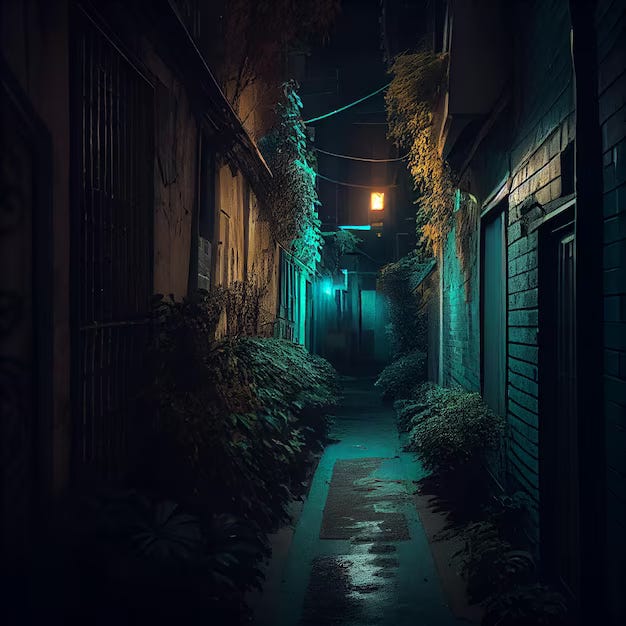
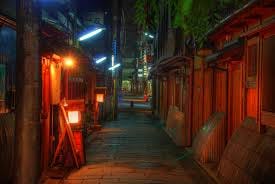

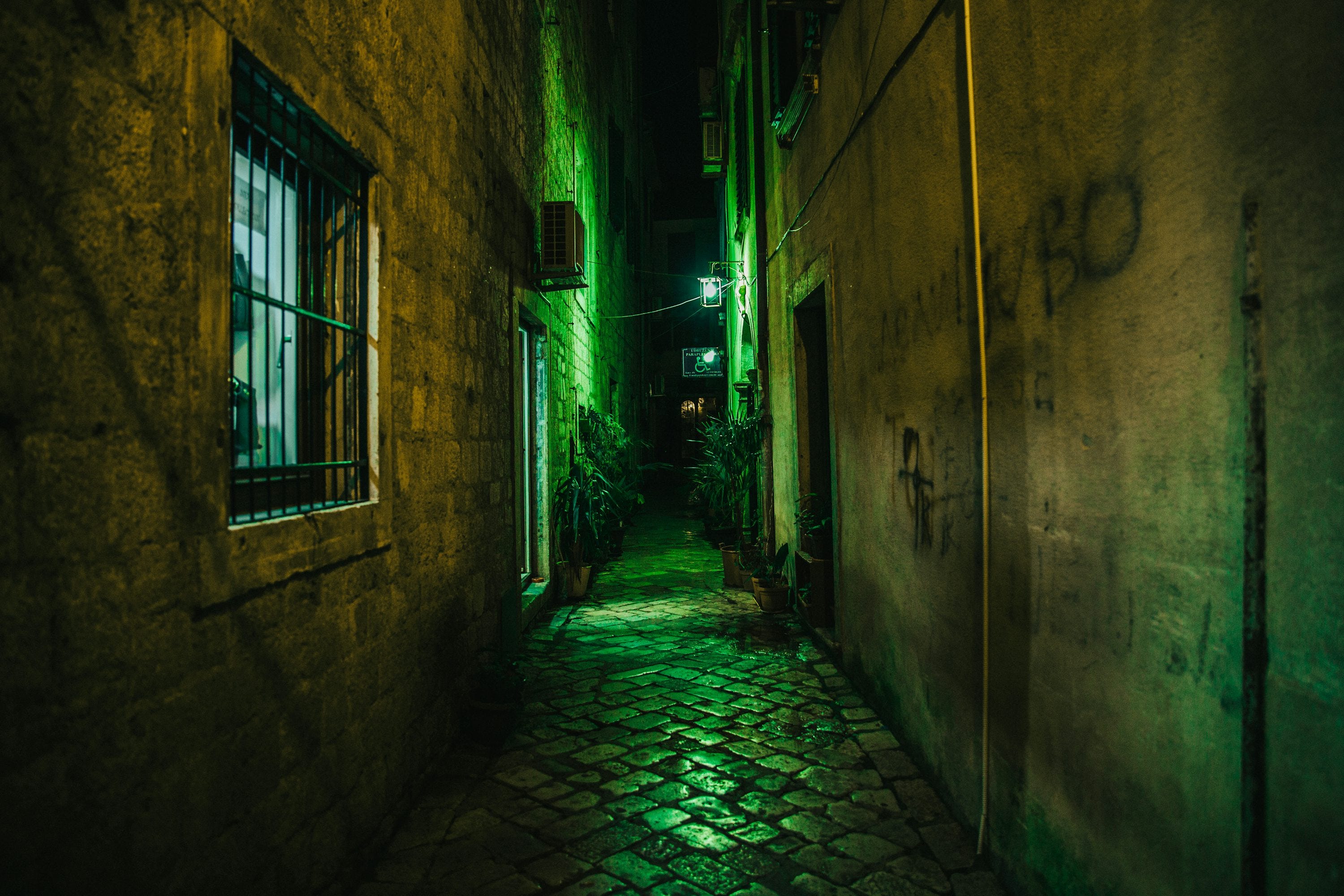
“Often, in conceiving a building, before I even have the outline of the volume clear, I look, in my mind, for a vision of the color,” Alexander writes
The color, in a holistic way, appears as a product of the forces on the site. One sees what kind of overall color structure may be most harmonious in that place, One can feel the harmony. One gets an idea, a glimpse, of the quality of color, hence the quality of structure which will help that part of the world, fit into it, so that it becomes more whole, more dazzling, in a quiet and unassuming way.
And, once the building exists, months or years later, the importance of light continues. Even the paint on the building, on the walls, on the furniture, on the garden fence, this is all essential.
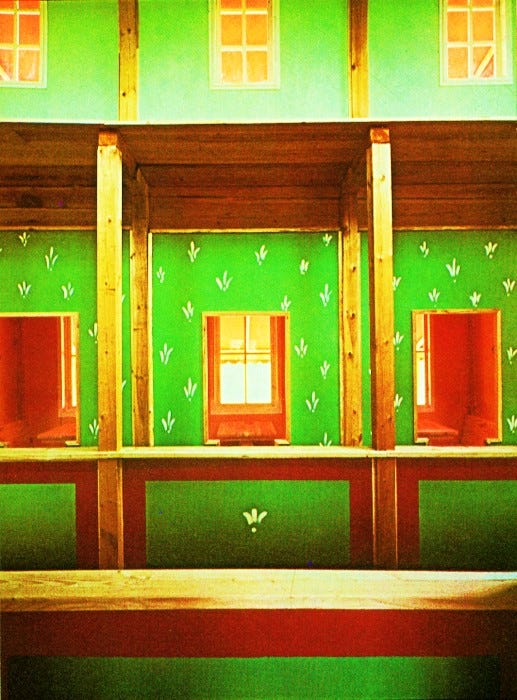
In order to allow the wholeness to unfold, the architect doesn’t work with ideas--- they work with space, feeling, color, and an intense sense of living centers --- each of which acts as a guide from this step to the next step. If you get too stuck in drawing centers, you must return to the colors; too much obsession with the colors means you must work with the feeling; overwhelmed with the feeling you must step back and ask the space what is wanting to be shaped by the process. These become the core themes of the final book.
Book Four: The Luminous Ground
In Book Four, all of Christopher Alexander’s insights are seen in terms of a deep, profound mystical light, the implications of which is a radically new vision of reality. Let’s pick up the theme of color to see how Alexander develops it further in book four.
Because this book’s central theme is about encountering the “I” which is “that interior element in a work of art, or in a work of nature, which makes one feel related to it. … It is the spirit which animates each living center.” One might say that the “I” is the felt-sense of the center, and the “center” is the living structure of the “I”.” In Chapter 7, Alexander wants to show us directly, visible, the I itself, and he is attempting this by showing us color, in particular “a kind of color which I believe allows the I to be seen.”
Of all the phenomena I know, this is the one which comes closest
to letting us see the I directly, as if we were actually looking at it.
It is what I call the phenomenon of inner light.
Alexander goes on to speak of color, first as fundamental to the structure of space wherein both space effects color and color effects the expression of space in a way that is more than just “pouring on paint” over a geometric surface. From this he goes on to talk about a special kind of unity that is generated by color which “lies in a realm which is not entirely accessible to structural descriptions.” Even the order which is described by the field of centers, although touches it and is necessary to this unity, it is through colors, and the inner light that is generates, that captures its essence --- they bring us to face the transcendental realm.
What could this possibly mean?
This deeper unity depends on a series of qualities in color, like the geometric properties we first learnt to see in the geometric field of centers, but now having to do with unity, not merely structure. In the geometric field, each of these properties is one of the ways in which centers can be built out of centers. In the realm of color, too, these properties somehow generate pure unity, by generating wholeness out of other wholeness. But in the realm of color, we hae, for the first time, also been confronted with an additional phenomenon: a purely unitary, non-structural aspect of wholeness. The aspect of wholeness which shines, like light, from the colored thing, and which pervades it, permeates, shines throughout it, as a whole.
Color renders the wholeness of centers a special kind of unity, an undivided quality which transcends structure and “seems to spring from the very ground of things directly to our consciousness.” Alexander interprets this “very ground of things” as the “I itself.” This suggests, to Alexander, that the ground can be directly perceived from this vantage point, and postulates the capacity of artists and builders to use colors in a more harmonious whole so that others might see the ground more directly.
As moderns, we have separated subjective and objective, qualia and quality, inner sensing and outer perception, spirit and matter. We recognize that these mover closer to us when we experience the wholeness that is Nature. In this school, we have bemoaned the fact that there is less and less natural environment for people to learn from. But Christopher Alexander’s insights are telling us that there is the same capacity to disclose the luminous ground, by attending to a certain, “living process” in the ways we go about making a living, arranging and creating our built world. He is saying that design matters because it is *world-building, *and world-building can express the deepest reality in the cosmos. This is why, he would argue, that earlier societies could create beautiful worlds --- something we as moderns have forgotten--- because this wound of separation had not hit them yet. A creators, they were taking up the role of The Creator, and understood the profound responsibility this entailed. Alexander writes
The profound wholeness which I have described …, the “mirror of the self,” in these things which ties them somehow to a person’s deep experience of life, has historically been created millions of times. After spending my life looking for these profound examples, I have reached the conclusion that the specific living quality I have identified and shown … almost every time that it has been done most profoundly, has been done in a mystical-religious context.
What is this “I”?
I believe, fundamentally, Alexander’s “I” is the experience of deep relation that is left when the subject and object frame dissolves. His insights are a first-person record of Whitehead’s “prehensive” universe, where this feeling-resonance is both source and ground, and the fundamental property of the “I”- sense of the experience. Alexander chooses the word “I” because the experience is personal, he writes
I feel the experience of the relationship with the tree as personal. It has to do with ME. I feel related to the tree, I feel that my own existence grows, extends, and becomes wholly good, as I experience my connection with the tree.
This “I” is personal, it is singular (every I-like thing encountered is the same in all the universe), and it is suffused with relatedness.
A certain kind of attention to things, Alexander discovers, has the effect of bleeding the objective and the subjective into an unbounded wholeness. The subject goes out or prehends the object, it is an intimate gesture; and the object is known as coming forward or prehending the self --- this too is intimacy.
Persons and things that have more life are capable of being transparent in this way. The dead world is opaque. Life, Alexander concludes, is this I-like presence, and its nature is unfolding wholeness.
With their I-like nature, Alexander wonders, is it possible to consider all living centers as beings, drawing attention to the animate quality that appears when connected to this I.
The Goal of Tears
I want to end this essay with two chapters from the final part of the final book that represent a twist in Alexander’s thought. Chapter 8 has the surprising title The Goal of Tears. The goal of tears is related to the unity of living wholeness, because
… if it is truly alive, one can feel it’s own death within it, even while it lives …
We can see that this is a deepening of the original idea of beauty as something that withstands and endures and is worn through time. The wearing-down of things let’s us know they are alive, they have all this life compressed down into them. We feel a living fire burn, like the sun, completely metabolizing itself. When tears well up in us, we feel we are touching something deeply true, real and sacred. Something both timeless and yet also fleeting. This is not the kind of ecstatic joy that the mystics talk about--- it is a kind of ecstatic sadness.
I think what makes things of beauty evoke sadness in us is that, in order to make them beautiful, you need to make them vulnerable. They have to surrender to time and change. Even those structures that endure time --- the pyramids, the Parthenon --- their beauty is eroded by time, by the loss of meaning, by their loss of centrality in the human system. Something that was alive in its contexts becomes only “precious” --- an heirloom devoid of its story. The new story is one of sadness, of a trail of tears. The sadness comes to us deeply and personally, when it is we who have built the structure and created its beauty, because we know we have designed into it its vulnerability.
This deep sadness, when experienced in a living environment, may not always appear outwardly beautiful or harmonious. For example, at one time, my backyard had ducks and fishes. The place where they lived was quite unimposing from a “designer” point of view.
The stones, rocks, concrete were a bit messed up. There were plastic pipes from the water circulating pumps; there was an old red pump propped up on the fence. The duck run, like a coop, was made of unexciting bits of wood and chicken-wire. There was straw on the ground, mud, and so on. Nevertheless, the backyard was the envy of all out neighbors. There is a low wall and an open fence. All our neighbors came to see the fish, even to take their daily walks with an aim of coming to say hello to the ducks and the fish. So it was very open.
I once heard two small boys walking past, in the street, and one said to the other “I wish I lived in that house.” Another day, a young woman was walking by, saw me working in the yard and said, “I love your house so much, it is like a paradise. I wish you would adopt me.” Hardly a day went by when it wasn’t like that, without someone coming by and telling us how much they enjoyed it. Yet it was the most ordinary thing in the world.
It is gone now. The garden is still there, but that feeling has vanished from it.
The Face of God
At the end of his work, Christopher Alexander believed that by taking on the creative process and putting it into service of life and beauty, one was actually acting as a conduit for manifesting God. “We do not need to wait for any afterlife,” Alexander writes, “because this wonderful transcendent thing happening before our eyes, is itself God, now.”
And this is the ultimate aim of all making: to make a thing which does manifest spirit, which shows us feeling, which makes God visible and shows us the ultimate meaning of existence, in the actual sticks and stones of the made thing.
For Alexander, both the path to God and the goal of manifesting God has to do with getting to a state of non-separateness.
… wholeness is the state in which each thing is continuous and part of the larger whole. It is a state in which the world is melted.
The connection between building and religion, Alexander discovers, is not historical, but very practical, empirical--- both teach people how to lose themselves, not only how to become non-separate but --- far harder--- how to become willing to become not-separate. And here Alexander bumps into the central mystery of it all. The things that are made from this state of non-separateness, are so unique, what they have to say is so unique, they become the most individuated, rare, precious and sacred.
If you see the watery pale yellow sunlight shining behind dark gray clouds, with the pale blue of heaven shining in between some wintery morning, and you see, in that light, the original light of the universe--- then, you may say, in still different terms, that sometimes, very occasionally, an artist who weaves a carpet, or who shapes a building, or who paints a tile, manages to make something which has this same light in it, where this same Self is shining out … he has made something as close to a picture of God or Self as it can be, and it affects us, like the light of morning does, because it seems to show us directly to the heart of this self, and connects us with it, almost to the point of pain.
Suggested Reading
Similar to Alexander’s work:
- Nikos A. Salingaros: Twelve Lectures on Architecture // A Theory of Architecture
Regenerative Design:
- Daniel Christian Wahl: Designing Regenerative Cultures
- Mang and Haggard: Regenerative Development and design
Philosophic:
- Mehaffy and Salingaros: Design for a Living Planet
- Arne Naess: The Ecology of Wisdom
Interactive- Participatory
- Young, Haas, McGown: Coyote’s Guide to Connecting with Nature
- Randolf T. Hester: Design for Ecological Democracy
Bonus Material
Cohorts
Note that access requires a paid membership.
Further Resources
Footnotes
-
Jenny Quillien, Pam Rostal and Dave West ↩
-
There is an interesting confluence here between the pattern-recognition AI and large language modles, and the engineering mindset to pattern languages. I would love to dive into this thought, but it is beyond the scope of this article. Maybe another day. ↩
-
An Essay on the Art of Building and the Nature of the Universe ↩
-
Ronen has compiled a great way to access all the four books by reading excerpts here https://iamronen.com/quality/christopher-alexander-the-nature-of-order/ ↩
-
Here is a wonderful example of the exercise https://iamronen.com/blog/2018/01/23/drawing-centers/ ↩